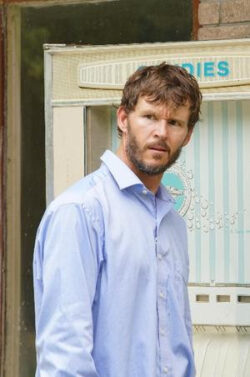Starring: Ry Barrett, Andrea Pavlovic and Cameron Love
Directed by: Chris Nash
Rated: NR
Running Time: 94 minutes
IFC Films and Shudder
Our Score: 4 out of 5 Stars
Is it possible to reinvent the slasher genre in the 21st century? I think there’s always a discussion about it, but I ultimately think it’s incredibly difficult, especially since some confuse reinvigorating with reinventing. It’s hard to transform the slasher genre because it’s solely built on the singular purpose of seeing people killed in brutal ways. I’m not saying it’s too simplistic, but I’ve rarely seen instances of films attempting to reinvent one of horror cinema’s greatest wheels. The most recent occurrence of reinvention is when Wes Craven unleashed “Scream” upon the world. That being said, “In a Violent Nature” comes pretty damn close.
I wasn’t sold immediately as “In a Violent Nature” opened on a deteriorating structure in the middle of a lush summertime forest. We hear a few men off-screen talking over the sounds of nature; birds, the rustling of trees in the soft breeze and the like. Then we see a locket necklace removed from a pipe shooting out of the ground. That removal is what causes our main character to emerge from the hardened, yet seemingly fresh dirt below. Johnny (Ry Barrett) crawls out of the Earth from his undead slumber and begins to shamble around the pristine woods around him. The cameras follow Johnny throughout “In a Violent Nature,” sometimes methodically, sometimes suspensefully, but ultimately with an unspoken purpose.
It’s easy to compare “In a Violent Nature” to a film like the remake of “Maniac,” where we see not only have a first person view of the killer’s world, but hear his internal monologue. “In a Violent Nature” is third person and we never get to hear what Johnny is thinking. You could almost say that we more or less see what happens during other slashers as our main killer lumbers towards an unspeakable goal or illogical destination. You can joke that in other slashers, the killer is generally just twiddling their thumbs or possibly checking their Instagram notifications as they await another teenage victim to slash and gash. Instead, we’re left to ponder for several long lapses what Johnny is doing. Revenge? Bloodlust? Boredom?
Come to think of it, I really wasn’t sold on “In a Violent Nature,” until the film’s second kill. The film juxtapositions these moments of brutality with Johnny calmly walking about. We see him as he encounters the stereotypical group of teenagers looking to camp in a place they shouldn’t be, and how he reacts. Johnny doesn’t necessarily react the way we’ve imagined Jason Vorhees or others before Johnny. Vorhees jump scares into the picture, machete in hand, and quickly mutilates his victims. Johnny just walks up. Is that what Vorhees, Krueger and Myers have been doing all along? Casually strolling up? Like slashers before him, Johnny seems focused on a singular notion, but what is that notion? What drives Johnny? At a certain point, does Johnny’s backstory answer our burning questions or merely attempt to explain the unexplainable? “In a Violent Nature” performs an autopsy and you’re left to wonder what all the different organs are and why some are disfigured while others aren’t.
The film checks all the slasher boxes, a memorable killer, creative and gruesome kills, the drowning feeling of isolation, and a pace that balances viciousness with quiet curiosity. Is “In a Violent Nature” a deconstruction of the genre, much like “Cabin in the Woods?” It’s difficult to say because the silence breeds speculation and ultimately makes the viewer deconstruct the film more than the genre. “In a Violent Nature” starts out as an homage and slowly becomes a social commentary like great slashers before it. Slashers have always tapped into societal trauma, like the breakdown of safe spaces, whether it be a pristine lake in the woods or the safety of a suburban community on Halloween. The main thing it tapped into was a fear of the unknown. It’s very human to be fearful or anxious of the uncertainty and unseen around us. It’s what made “The Strangers” so effective, murderers can come for you just because. So, in today’s digital age of data where we have access to a wide range of sources and information, we fail to remember one thing that “In a Violent Nature” reminds us of, some things will never be explained. Johnny, just like the universe, may just be random and cruel. While some may suffer fates worse than death, survivors will be haunted by its unanswered questions.
















